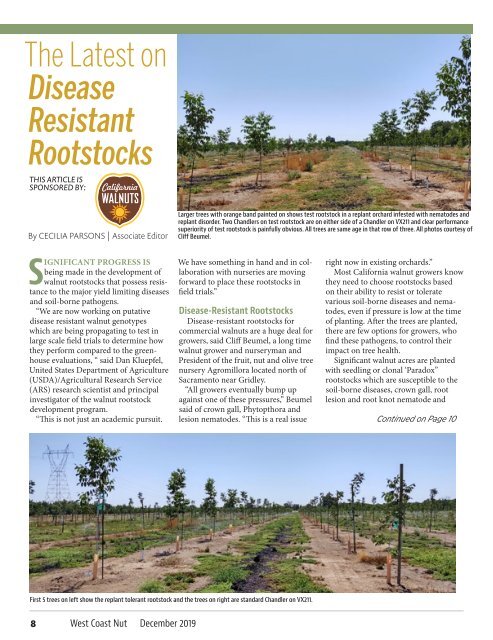WCN December 2019
You also want an ePaper? Increase the reach of your titles
YUMPU automatically turns print PDFs into web optimized ePapers that Google loves.
l<br />
m,<br />
tility<br />
generated over $15 in tax revenue<br />
creation.2<br />
Spending on export promotion in<br />
2017 created 2,682 jobs.2<br />
The Latest on<br />
Disease<br />
66% Resistant<br />
Rootstocks<br />
THIS ARTICLE IS<br />
SPONSORED BY:<br />
66% of the California<br />
walnut crop was exported<br />
in the 2017/18 crop year.<br />
By CECILIA PARSONS walnuts.org | Associate Editor<br />
Larger trees with orange band painted on shows test rootstock in a replant orchard infested with nematodes and<br />
replant disorder. Two Chandlers on test rootstock are on either side of a Chandler on VX211 and clear performance<br />
superiority of test rootstock is painfully obvious. All trees are same age in that row of three. All photos courtesy of<br />
Cliff Beumel.<br />
SIGNIFICANT PROGRESS IS<br />
being January made 2018, Harry in M. Kaiser, the Cornell development University of<br />
walnut rootstocks that possess resistance<br />
to the major yield limiting diseases<br />
and soil-borne pathogens.<br />
“We are now working on putative<br />
disease resistant walnut genotypes<br />
which are being propagating to test in<br />
large scale field trials to determine how<br />
they perform compared to the greenhouse<br />
evaluations, “ said Dan Kluepfel,<br />
United States Department of Agriculture<br />
(USDA)/Agricultural Research Service<br />
(ARS) research scientist and principal<br />
investigator of the walnut rootstock<br />
development program.<br />
“This is not just an academic pursuit.<br />
1 California Agricultural Statistics Review 2016/2017 by CDFA<br />
2 Economic Evaluation of the California Walnut Commission’s Export<br />
Promotion Programs: An Analysis of the Direct and Indirect Impacts,<br />
We have something in hand and in collaboration<br />
with nurseries are moving<br />
forward to place these rootstocks in<br />
field trials.”<br />
Disease-Resistant Rootstocks<br />
Disease-resistant rootstocks for<br />
commercial walnuts are a huge deal for<br />
growers, said Cliff Beumel, a long time<br />
walnut grower and nurseryman and<br />
President of the fruit, nut and olive tree<br />
nursery Agromillora located north of<br />
Sacramento near Gridley.<br />
“All growers eventually bump up<br />
against one of these pressures,” Beumel<br />
said of crown gall, Phytopthora and<br />
lesion nematodes. “This is a real issue<br />
right now in existing orchards.”<br />
Most California walnut growers know<br />
they need to choose rootstocks based<br />
on their ability to resist or tolerate<br />
various soil-borne diseases and nematodes,<br />
even if pressure is low at the time<br />
of planting. After the trees are planted,<br />
there are few options for growers, who<br />
find these pathogens, to control their<br />
impact on tree health.<br />
Significant walnut acres are planted<br />
with seedling or clonal ‘Paradox”<br />
rootstocks which are susceptible to the<br />
soil-borne diseases, crown gall, root<br />
lesion and root knot nematode and<br />
Continued on Page 10<br />
First 5 trees on left show the replant tolerant rootstock and the trees on right are standard Chandler on VX211.<br />
8<br />
West Coast Nut <strong>December</strong> <strong>2019</strong>


















